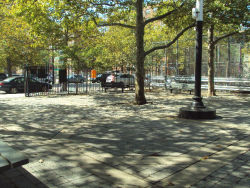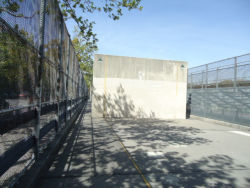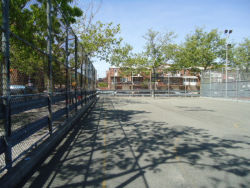Yak Playground
Yak Playground
Nothing is more rare than a yak in New York City, except for here in Sheepshead Bay at Yak Playground, where the name is derived from Avenue Y, the street that borders it.
The yak (Bos grunniens) is a Tibetan ox, native to the mountainous regions of Central Asia. Listed as an endangered species, it is used as a beast of burden, as well as for its meat, milk and hide. An enormous blackish-brown and bushy-haired animal, yaks can grow to heights of 6 feet (at the shoulder) and weigh over a ton.
Sheepshead Bay also derives its name from the animal kingdom. The Sheepshead fish (Archosargus probatocephalus), silvery and black-banded, is native to the Atlantic coast and can be found from Nova Scotia south to the Gulf of Mexico. It gets its name from the shape of its teeth, which resemble those of sheep.
The Canarsee Indians were the original inhabitants of this area, and lived here largely undisturbed until almost 150 years after European settlers arrived in nearby Gravesend in 1643. In the 17th century, the Wyckoff and Lott families established homesteads and built farms. The Henry and Abraham Wyckoff House, built in 1766, still stands today on the corner of Kings Highway and East 22nd Street.
Fishing became popular in the bay in the early 1800s, and little cottages soon dotted the rim of the inlet. Cool coastal breezes and fresh seafood began to lure tourists in the middle of the 19th century, and the name Sheepshead Bay likely dates from this era. Benjamin Freeman built the first hotel in the area, The Sheepshead, in 1844, and Sam Leonard’s Hotel and Tappen’s Hotel soon followed. The opening of Ocean Avenue in 1876 provided the first direct route to the area. In the 1870s, the subdivision of a large farm for development began a trend that led to the construction of over 400 houses along with shops, churches, and a post office. Political boss John Y. McKane (1841-1899) guided the development of Sheepshead Bay by encouraging the construction of New York rail lines to connect it to the rest of Brooklyn.
After the Coney Island Jockey Club opened the Sheepshead Bay Race Track in 1880, gamblers flocked to the area. Legend has it that the nearby Holwell Mansion was the site of one of the first tipster rackets, where timers watched trial races and sold information to bookmakers. In 1911, the racetrack also served as the take-off runway for the first airplane to make a transcontinental flight to California, the Vin Fiz, piloted by Calbraith P. Rodgers. The $3,500,000 Sheepshead Speedway replaced the track when the Jockey Club disbanded in 1915, but was demolished in 1919 to make way for housing. The city revitalized the neighborhood in the 1930s with improvements such as the widening of Emmons Avenue and the modernization of bay-side buildings. In the 1950s, brick apartment buildings replaced wooden houses, and by 1960, Sheepshead Bay was the fastest growing community in Brooklyn.
Formerly known as part of the Sheepshead Bay High School Athletic Fields, Yak Playground was renamed by Parks Comissioner Henry J. Stern in 1999. Parks jointly operates this playground with the Board of Education, to serve the students of Sheepshead Bay High School as well as the greater community. The land was acquired by the City in 1953, and the playground first opened on October 28, 1961, originally including a baseball diamond, fields for football and soccer, a high jump and broad jump, a running track, basketball and handball courts, and a public restroom. A 1987-1990 renovation by the Board of Education converted the football field to astroturf, extended the track, and installed new 1,000-seat bleachers.
Check out your park's Vital Signs
Clean & Safe
Green & Resilient
Empowered & Engaged Users
Share your feedback or learn more about how this park is part of a
Vital Park System



